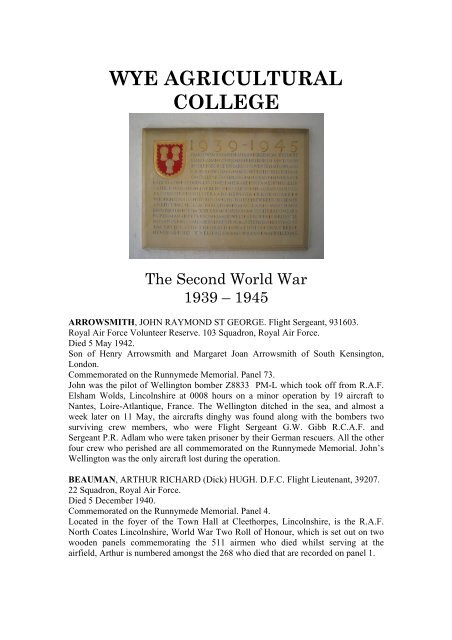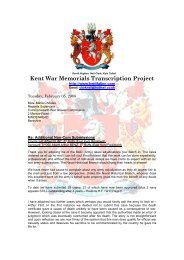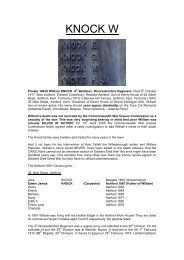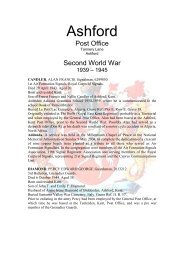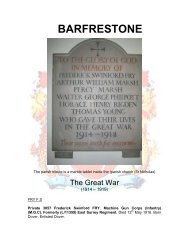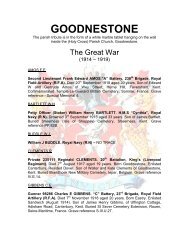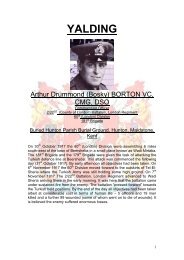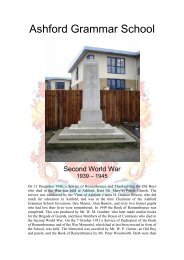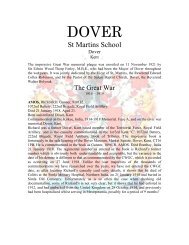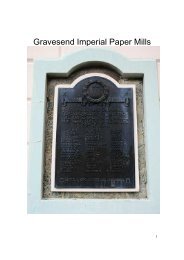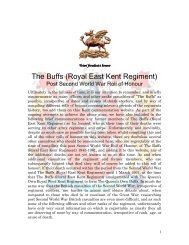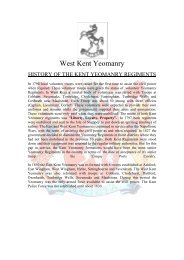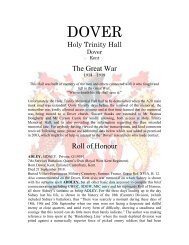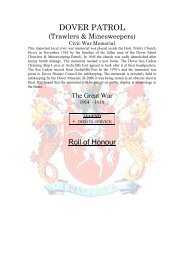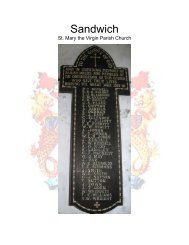Wye College - Kent Fallen
Wye College - Kent Fallen
Wye College - Kent Fallen
Create successful ePaper yourself
Turn your PDF publications into a flip-book with our unique Google optimized e-Paper software.
WYE AGRICULTURAL<br />
COLLEGE<br />
The Second World War<br />
1939 – 1945<br />
ARROWSMITH, JOHN RAYMOND ST GEORGE. Flight Sergeant, 931603.<br />
Royal Air Force Volunteer Reserve. 103 Squadron, Royal Air Force.<br />
Died 5 May 1942.<br />
Son of Henry Arrowsmith and Margaret Joan Arrowsmith of South Kensington,<br />
London.<br />
Commemorated on the Runnymede Memorial. Panel 73.<br />
John was the pilot of Wellington bomber Z8833 PM-L which took off from R.A.F.<br />
Elsham Wolds, Lincolnshire at 0008 hours on a minor operation by 19 aircraft to<br />
Nantes, Loire-Atlantique, France. The Wellington ditched in the sea, and almost a<br />
week later on 11 May, the aircrafts dinghy was found along with the bombers two<br />
surviving crew members, who were Flight Sergeant G.W. Gibb R.C.A.F. and<br />
Sergeant P.R. Adlam who were taken prisoner by their German rescuers. All the other<br />
four crew who perished are all commemorated on the Runnymede Memorial. John’s<br />
Wellington was the only aircraft lost during the operation.<br />
BEAUMAN, ARTHUR RICHARD (Dick) HUGH. D.F.C. Flight Lieutenant, 39207.<br />
22 Squadron, Royal Air Force.<br />
Died 5 December 1940.<br />
Commemorated on the Runnymede Memorial. Panel 4.<br />
Located in the foyer of the Town Hall at Cleethorpes, Lincolnshire, is the R.A.F.<br />
North Coates Lincolnshire, World War Two Roll of Honour, which is set out on two<br />
wooden panels commemorating the 511 airmen who died whilst serving at the<br />
airfield, Arthur is numbered amongst the 268 who died that are recorded on panel 1.
Arthur was the pilot of the Coastal Command Beaufort OA-B, which took off from<br />
R.A.F. North Coates, Lincolnshire at 0645 hours to carry out a ‘Rover Patrol.’ The<br />
Beaufort was last seen over the North Sea off the port of Wilhelmshaven, Germany,<br />
enemy radio reports later gave the information that the aircraft had been shot down.<br />
All four crew of the Beaufort are commemorated on the Runnymede Memorial.<br />
BENTON, GEORGE KENYON. Lieutenant, 235219.<br />
2nd Lothians and Border Horse, Royal Armoured Corps.<br />
Died 11 January 1943. Aged 33.<br />
Born and resided <strong>Kent</strong>.<br />
Son of George Kenyon Benton and Elsie Dora Benton.<br />
Husband of Edna May Benton of Maidstone, <strong>Kent</strong>.<br />
Commemorated Medjez-el-Bab War Cemetery, Tunisia.<br />
Grave Ref: Special Memorial 15. H. 20.<br />
BLEWITT, WILLIAM. Lieutenant, 164767.<br />
3rd Battalion, Parachute Regiment, Army Air Corps.<br />
Died 6 January 1943. Aged 20.<br />
Born and resided Essex.<br />
Son of Lieutenant Colonel Guy Blewitt D.S.O., M.C. and of Audrey Blewitt of<br />
Boxford, Essex.<br />
Buried Tabarka Ras Rajel War Cemetery, Tunisia. Grave Ref: 1. E. 22.<br />
William’s father commanded the 2nd Battalion, Oxfordshire and Buckinghamshire<br />
Light Infantry during the Great War.<br />
BUCHANAN, D. L. Lieutenant, 103166.<br />
24 Squadron, South African Air Force.<br />
Died 2 July 1941. Aged 27.<br />
Son of Douglas M. and Elsie L. Buchanan of Kenilworth, Capt Town, South Africa.<br />
Commemorated on the Alamein Memorial, Egypt. Column 245.<br />
Lieutenant Buchanan who was a B.A. (Cantab); Trinity <strong>College</strong> Cambridge, was the<br />
pilot of the A22 Maryland bomber 1615, which took off from Landing Ground 17<br />
(Fuka Main), to take part in a night bombing raid on Derna, Libya in the region of<br />
Cyrenaica. Over the target area the Maryland was shot down by enemy flak gunners.<br />
At the time of the loss of the bomber and its four crew, who are all commemorated on<br />
the Alamein Memorial. 24 Squadron, S.A.A.F. which had been formed in Kenya on 5<br />
March 1941, and at the time of Lieutenant Buchanan’s death was serving in the<br />
Western Desert, mainly operating from various Advanced Landing Grounds.<br />
BULMER, OSCAR THEODORE. Captain, 87117.<br />
1st Battalion, Hertfordshire Regiment, King’s Shropshire Light Infantry.<br />
Died 9 September 1944.<br />
Born Hereford. Resided Dorset.<br />
Buried Geel War Cemetery, Antwerpen, Belgium. Grave Ref: II. C. 7.
BURFIELD, BERNARD JOHN. Major, EC/2984. (Indian Army).<br />
7th Battalion, 2nd Punjab Regiment.<br />
Died 13 February 1944.<br />
Buried Taukkyan War Cemetery, Myanmar. Grave Ref: 5. A. 4.<br />
CLOUGH, A.H. As commemorated on the <strong>Wye</strong> <strong>College</strong> Second World War<br />
memorial plaque, is probably the following casualty. Unfortunately he appears to be<br />
numbered amongst the thousands of Commonwealth fallen of both world wars, who<br />
still have no form of CWGC commemoration or rememberance:-<br />
CLOUGH, Arthur H. Gunner, 15898583.<br />
Royal Artillery.<br />
Died at sea 3 August 1942.<br />
Born and resided <strong>Kent</strong>.<br />
COLE, JOHN DENIS. Flight Lieutenant (Pilot), 118067.<br />
Royal Air Force Volunteer Reserve. 158 Squadron, Royal Air Force.<br />
Died 3 April 1943. Aged 27.<br />
Son of Thomas Robert and Florence Cole of Alexandria, Egypt.<br />
Buried Rheinberg War Cemetery, Kamp Lintfort, Nordrhein-Westfal, Germany.<br />
Grave Ref: 9. B. 8.<br />
John was the pilot of Halifax bomber DT635 NP-F which took of from R.A.F.<br />
Lissett, Yorkshire at 1942 hours on 3 April 1943, it being one of 113 Halifax bombers<br />
in a mixed bomber force of 348 aircraft on a mission to Essen, Germany. Significantly<br />
the raid was the first which had in excess of 200 Lancasters which numbered 225.<br />
Due to inclement weather which prevailed over the target area the Pathfinder Force<br />
aircraft at the head of the main bomber force in addition to the usual ground-marking<br />
they also skymarked above the area of attack, despite an element of confusion<br />
amongst the following aircraft due to the additional marking they achieved a higher<br />
proportion of accurate targeting than that which had previously been managed on<br />
previous raids on Essen which resulted in significant damage in the centre and<br />
western half of the city. John’s aircraft crashed near Mönchengladbach where the<br />
seven crew were interred in the Stadtfriedhof. Since the cessation of hostilities their<br />
remains have been taken to the Rheinberg War Cemetery. John had passed the<br />
halfway stage of his tour of operations, as had his aircraft, which had completed<br />
fourteen operations since being taken on charge on 31 December 1942. 158 Squadron<br />
also lost two other aircraft on the same mission to Essen. Only three of the twenty one<br />
crew members from the squadrons three Halifax bombers which were destroyed<br />
survived, but they were all injured in the crash.<br />
COVENTRY, GEORGE WILLIAM REGINALD VICTOR. Lieutenant, 7903.<br />
10th Earl of Coventry.<br />
7th Battalion, Worcestershire Regiment.<br />
Died 27 May 1940. Aged 39.<br />
Born 10 September 1900 Worcestershire. Resided Worcestershire.<br />
Son of the late George William Coventry, Viscount Deerhurst, and the Viscountess<br />
Deerhurst (neé Daniel), who died 8 November 1948.<br />
Husband of Nesta Donne (neé Philips), Countess of Coventry of Llanstephan,<br />
Carmarthenshire.<br />
Buried Givenchy-les-la-Bassee Communal Cemetery, Pas de Calais, France.<br />
Grave Ref: Row A. Grave 2.
The Earl of Coventry who was a pre war member of the Worcestershire Regiment,<br />
married The Honourable Nesta Donne Philips, the 17 year old daughter of Sir Owen<br />
Donne Philips G.C.M.G., M.P. on 17 September 1921. He was killed in action at<br />
Givenchy-les-la-Bassee, Pas de Calais, France, during the British Expeditionary Force<br />
retirement, in the France and Belgium Campaign.<br />
COWLAND-COOPER, MICHAEL TWISS. BSc. Major, 93179.<br />
1/4th Battalion, Hampshire Regiment.<br />
Died 20 October 1944. Aged 28.<br />
Born <strong>Kent</strong>. Resided Oxfordshire.<br />
Son of Charles Paul and Adelaide Cowland-Cooper.<br />
Husband of Peggy Louise Cowland-Cooper of Bicester, Oxfordshire.<br />
Buried Ramleh War Cemetery, Israel. Grave Ref: 5. J. 3.<br />
CRAGG, RONALD WEBB. Captain, EC/2330.<br />
3rd Queen Alexandra’s Own Gurkha Rifles.<br />
Died 1 July 1942.<br />
Commemorated on the Alamein Memorial, Egypt. Column 207.<br />
CROWDER, MARTIN KEITH. Captain, 129506.<br />
2nd Battalion, Rifle Brigade.<br />
Died 17 December 1942. Aged 24.<br />
Born India. Resided Surrey.<br />
Son of Martin Henry and Margaret Barbara Crowder of East Molesey, Surrey.<br />
Buried Ramleh War Cemetery, Israel. Grave Ref: 3. C. 1.<br />
CRUICKSHANK, JOHN IMAY. Sub-Lieutenant.<br />
Royal Naval Volunteer Reserve, H.M.S. Indomitable.<br />
Died 12 August 1942. Aged 23.<br />
Son of Peter and Anne McKay Cruickshank of Aberdeen.<br />
Commemorated on the Lee-on-Solent Memorial, Hampshire. Bay 4. Panel 1.<br />
As opposed to the other Naval Memorials, Lee-on –Solent has just the names of Fleet<br />
Air Arm personnel who have the sea as their graves inscribed on it, and has almost<br />
2000 of their number commemorated. John’s ship a 30,530 ton Aircraft Carrier,<br />
received two direct hits by enemy bombers whilst she was taking part in ‘Operation<br />
Pedestal’ (Malta Convoy), at which time a 1100 pound bomb pierced the flight-deck<br />
armour, 47 were killed during the bombing and the ship was put out of action for six<br />
months.<br />
CULLEY, GEOFFREY MATTHEW. Sergeant (Wireless Op/Air Gunner), 1164676.<br />
Royal Air Force Volunteer Reserve. 39 Squadron, Royal Air Force.<br />
Died 17 May 1942. Aged 25.<br />
Son of Captain G.M.C. Culley and Elizabeth F. Culley of Alresford, Hampshire.<br />
Buried Tobruk War Cemetery, Libya. Grave Ref: 1. B. 17.<br />
Geoffrey’s father served as a Captain in the 9th Scottish Rifles, and the Queen’s Own<br />
(Royal West <strong>Kent</strong> Regiment) during the Great War. Geoffrey’s squadron carried out<br />
its first wartime bombing mission, with a strike against the railway marshalling yards<br />
at Diredawa in Abyssinia on the day after Italy’s declaration of war. Bombing raids<br />
against Abyssinia and Eritrea continued until August 1940, by this time losses had<br />
reduced the squadron strength to only five aircraft. The squadron was then withdrawn
to Helwan in Egypt, flying in General Wavell’s offensive. In January 1941, the<br />
squadrons remaining aircraft were transferred to No. 11 Squadron, R.A.F. on Crete.<br />
The personnel then enjoyed a brief respite from flying operations, being mockingly<br />
referred to as the “39th Regiment of Foot.” In August 1941, 39 Squadron, R.A.F. was<br />
partially re-equipped with Bristol Beaufort torpedo bombers, which were quickly put<br />
to work conducting Maritime Reconnaissance and torpedo strike sorties. The<br />
squadron was successful in its new role, torpedoing the liner ‘Victoria’ on 23 January<br />
1942, and on 9 March 1942 sunk an enemy destroyer, crippling a cruiser and a<br />
merchant ship, in addition to shooting down two enemy aircraft. During 1942 the<br />
squadron became fragmented, with detached flights operating from Malta and various<br />
airfields in Egypt, including Shallufa, where Geoffrey was probably based at the time<br />
of his demise.<br />
CURLING, CHRISTOPHER HIGHAM. Flight Sergeant, 748682.<br />
Royal Air Force Volunteer Reserve. 160 Squadron, Royal Air Force.<br />
Died 2 December 1942. Aged 24.<br />
Son of John Harris Curling and Ethel Byron Curling of Faversham, <strong>Kent</strong>.<br />
Buried Fayed War Cemetery, Egypt. Grave Ref: 1. B. 23.<br />
DEANE, MARCUS HUGH. Captain, EC/96. (Indian Army).<br />
3rd Battalion, 7th Punjab Regiment.<br />
Died 22 July 1942.<br />
Buried El Alamein War Cemetery, Egypt. Grave Ref: XIII. C. 18.<br />
DEANE, MAURICE NEVILLE. Major, EC/894.<br />
3rd Battalion, 4th Prince of Wales Own Gurkha Rifles.<br />
Died India 3 September 1944.<br />
Buried Delhi War Cemetery, India. Grave Ref: 1. K. 7.<br />
DODGSON, RAYMOND AUSTEN. Second Lieutenant.<br />
1st Battalion, Northern Rhodesia Regiment.<br />
Died 18 August 1940.<br />
Buried Hargeisa War Cemetery, Somalia. Grave Ref: C. 28.<br />
At the start of the Second World War, the 1st Battalion, Northern Rhodesia Regiment<br />
was dispatched to guard the Belgian Congo border from an imagined invasion by a<br />
mythical 1300-strong mechanized force supposedly raised in Portuguese Angola.<br />
Recalled three weeks later, Raymond’s battalion then moved overland to Kenya<br />
during which time a stop was made to undertake training in Tanganyika. The battalion<br />
sailed from Mombasa on 11 May 1940, and reached Berbera in north-western<br />
Somalia four days later, and then occupied the Tug Argan position. Raymond’s<br />
battalion defended there during the Italian invasion of British Somaliland, along with<br />
such legendary formations as the Somaliland Camel Corps, until being forced to<br />
withdraw and evacuate by sea to Aden on 16 August. Later the battalion sailed back<br />
to Mombasa, where it arrived on 17 September, and was then in the 21st East African<br />
Infantry Brigade, 11th African Division, then the 1st South African Division. After<br />
advancing in May from Moyale, as part of the Cunningham offensive from Kenya, the<br />
battalion served on garrison duty in Abyssinia and Kenya.
DOUGLAS-JONES, GORDON SHOLTO. Second Lieutenant, 126687.<br />
234 Heavy Anti-Aircraft Battery, Royal Artillery.<br />
Died 24 May 1941. Aged 28.<br />
Born <strong>Kent</strong>. Resided Leicestershire.<br />
Son of Lieutenant Colonel Edwyne Douglas Douglas-Jones, formerly of the Royal<br />
Artillery, and Sina Gertrude Pott Douglas-Jones of Worthing, Sussex.<br />
Commemorated on the Athens Memorial, Greece. Face 2.<br />
Gordon’s father served during the Great War as a Major in the Royal Artillery.<br />
DRAKE, MICHAEL INGALTON. Captain, 121530.<br />
47 Light Anti-Aircraft Regiment, Royal Artillery. (Territorial Army).<br />
Died 1 September 1944. Aged 27.<br />
Born Surrey. Resided Sussex.<br />
Son of Mr and Mrs Francis Ingalton Drake.<br />
Nephew of Miss L.C. Page of Hove, Sussex.<br />
Buried Florence War Cemetery, Italy. Grave Ref: XII. G. 4.<br />
EAMES, RICHARD KNIGHT. Flight Lieutenant (Pilot), 133350.<br />
Royal Air Force Volunteer Reserve.<br />
Died 12 December 1944. Aged 31.<br />
Son of Sidney James Knight Eames and Ethel Wyles Eames of Apuldram, Chichester,<br />
Sussex.<br />
Buried Apuldram (St Mary the Virgin) Churchyard, Chichester, Sussex.<br />
Diploma, South-Eastern Agricultural <strong>College</strong>, <strong>Wye</strong>, <strong>Kent</strong>.<br />
EGELER, THOMAS HENRY. Sergeant (Instructor), X/5482.<br />
Rhodesian African Rifles.<br />
Died 29 February 1944.<br />
Buried Harare (Pioneer) Cemetery, Zimbabwe.<br />
Grave Ref: European War Graves Plot. Grave 125.<br />
FIELD-MARSHAM, CHARLES AUSTEN. Lieutenant, 52819.<br />
Life Guards.<br />
Died 15 January 1941. Aged 31.<br />
Born London 3 November 1910. Resided <strong>Kent</strong>.<br />
Son of Major Charles George Field-Marsham, and Mrs. Mary Dorothea Field-<br />
Marsham (neé Knight).<br />
Husband of Joan Helen Field-Marsham (neé Neville).<br />
Father of Robert Charles Edward Field-Marsham.<br />
Buried Fordcombe (St. Peter) Churchyard, Penshurst, <strong>Kent</strong>.<br />
FRENCH, JOHN GAY. Second Lieutenant, 50381.<br />
308 Battery, 55 Anti-Aircraft Regiment, Royal Artillery.<br />
Died 16 November 1939. Aged 33.<br />
Born London. Resided West London.<br />
Son of Dr. J. Gay French M.D. and Eleanor French.<br />
Husband of Kathleen Heather French of Redlynch, Wiltshire.<br />
Buried Graveney, Faversham, <strong>Kent</strong> (All Saints) Churchyard.<br />
Pre war member of the Royal Artillery.
Unit details are as accessed from John’s CWGC commemoration, which does not<br />
record his regiment as Heavy/Light etcetera. Probably John was serving as an officer<br />
in the 55 (<strong>Kent</strong>) Heavy Anti-Aircraft Regiment, Royal Artillery.<br />
GIBSON, RODNEY STUART. Captain, 87164.<br />
7th Battalion, Royal Norfolk Regiment.<br />
Died 7 August 1944. Aged 26.<br />
Born Bedford. Resided Norfolk.<br />
Son of Clifford Stuart Gibson and Mabel Joan Gibson of King’s Lynn, Norfolk.<br />
Husband of Helen Gibson.<br />
Buried Bayeux War Cemetery, Calvados, France. Grave XXII. F. 22.<br />
Pre war member of the Royal Norfolk Regiment.<br />
BSc (Lond), Diploma Agriculture (<strong>Wye</strong>).<br />
On the day that Rodney lost his life, the events surrounding his battalion are well<br />
documented, primarily as the result of the award of the Victoria Cross to a fellow<br />
Captain, who obviously Rodney would have known well. To add brief details<br />
appertaing to the action fought by Rodney’s battalion at Grimbosq on the River Orne,<br />
the London Gazette entry published on 26 October 1944, announcing the award of the<br />
Victoria Cross to Captain David Auldgo Jamieson, The Royal Norfolk Regiment will<br />
suffice. “Captain Jamieson was in command of a Company of The Royal Norfolk<br />
Regiment which established a bridgehead over the River Orne, south of Grimbosq in<br />
Normandy. On 7th August 1944 the enemy made three counter-attacks which were<br />
repulsed with heavy losses. The last of these took place at 18:30 hours when a<br />
German Battle Group with Tiger and Panther tanks attacked and the brunt of the<br />
fighting fell on Captain Jamieson's Company. Continuous heavy fighting ensured for<br />
more than four hours until the enemy were driven off, after suffering severe casualties<br />
and the loss of three tanks and an armoured car accounted for by this Company.<br />
Throughout these actions, Captain Jamieson displayed outstanding courage and<br />
leadership, which had a decisive influence on the course of the battle and resulted in<br />
the defeat of these determined enemy attacks. On the morning of 8th August, the<br />
enemy attacked with a fresh Battle Group and succeeded in penetrating the defences<br />
surrounding the Company on three sides. During this attack two of the three tanks in<br />
support of the Company were destroyed and Captain Jamieson left his trench under<br />
close range fire from enemy arms of all kinds and went over to direct the fire of the<br />
remaining tank, but as he could not get in touch with the commander of the tank by<br />
the outside telephone, he climbed upon it in full view of the enemy. During this<br />
period Captain Jamieson was wounded in the right eye and left forearm but when his<br />
wounds were dressed he refused to be evacuated. By this time all the other officers<br />
had become casualties so Captain Jamieson reorganised his Company, regardless of<br />
personal safety, walking amongst his men in full view of the enemy, as there was no<br />
cover. The enemy counter-attacked the Company three more times during that day<br />
with infantry and tanks. Captain Jamieson continued in command, arranging for<br />
artillery support over his wireless and going out into the open on each occasion to<br />
encourage his men. By the evening the Germans had withdrawn, leaving a ring of<br />
dead and burnt out tanks round his position. Throughout this thirty-six hours of bitter<br />
and close fighting, and despite the pain of his wounds, Captain Jamieson showed<br />
superb qualities of leadership and great personal bravery. There were times when the<br />
position appeared hopeless, but on each occasion it was restored by his coolness and<br />
determination. He personally was largely responsible for the holding of this important<br />
bridgehead over the River Orne and the repulse of seven German counter-attacks with
great loss to the enemy.” David Jamieson V.C. died at his home in Burnham Market,<br />
Norfolk, on 5 May 2001, aged 80 and is buried in Burnham Norton Cemetery.<br />
GRAHAM-HOGG, HORACE GAULTERUS. Flying Officer (Pilot), 39516.<br />
57 Squadron, Royal Air Force.<br />
Died 14 April 1940. Aged 27.<br />
Son of George Henry and Alice L Hogg.<br />
Buried Arnhem (Moscowa) General Cemetery, Gelderland, Netherlands.<br />
Grave Ref: Collective grave 1.<br />
Horace was the pilot of Blenheim bomber L9465 DX-? which took off on a<br />
reconnaissance mission from an advanced base at Rosières-en-Santerre, Somme,<br />
France. At approximately 1600 hours, the aircraft was shot down by a Messerschmitt<br />
Me109, which was flown by Leutnant Lignitz of 1./JG20, over Babberich,<br />
Gelderland, Holland. At the time of Horace’s demise his squadron was equipped with<br />
Blenheim IV bombers, and later suffered staggering loses in support of the British<br />
Expeditionary Force. The other casualties who are interred with Horace are the other<br />
two crew members of the same aircraft. A month after Horace was killed it was a<br />
Blenheim that carried out the first of his squadron’s bombing missions of the war on<br />
12 May 1940, bombing Chaulnes whilst engaged on an armed-reconnaissance flight.<br />
GRIFFITH, BRIAN SAMUEL. BA (Oxon). Lieutenant, 155408.<br />
Royal Artillery. Attached to 3 Light Anti-Aircraft Battery, Royal Indian Artillery.<br />
Died 7 March 1942. Aged 26.<br />
Born Surrey. Resided South West London.<br />
Husband of Deirdre Griffith of Waltham, Canterbury, <strong>Kent</strong>.<br />
Commemorated on the Rangoon Memorial, Myanmar. Face 2.<br />
HELLYER, DENIS. Pilot Officer (Observer), 104573.<br />
Royal Air Force Volunteer Reserve. 156 Squadron, Royal Air Force.<br />
Died 20 May 1942. Aged 25.<br />
Son of Frank Orlando and Hilda Evelyn Hellyer of Guildford, Surrey.<br />
Buried Hargnies Communal Cemetery, Ardennes, France.<br />
Grave Ref: Collective grave.<br />
Denis was a crew member of Wellington bomber X3671 GT-?, which was flown by<br />
26 year old Squadron Leader (Pilot), Thomas F. McGillivray D.F.C. of North<br />
Berwick, East Lothian, Scotland. The aircraft took off from R.A.F. Alconbury,<br />
Cambridgeshire on a bombing mission to Mannheim, Germany, the aircraft being one<br />
of 105 Wellingtons in a mixed bomber force of 197.Despite 155 crews reporting<br />
successful bombing at the debriefing after the raid it later transpired that their claims<br />
were somewhat optimistic as most of their bombs dropped had fallen in open county<br />
or in surrounding forests, the bulk of the damaged to Mannheim was by caused when<br />
approximately 600 incendiaries which fell in the harbour area on the Rhine burnt out<br />
four small industrial premises, which cost the lives of two of the firemen dealing with<br />
them. Denis’s Wellington crashed (cause still unknown) near the village of Hargnies,<br />
Ardennes, France near the French-Belgium border, killing all six crew who are<br />
interred together, they being the only servicemen interred within the village cemetery.<br />
Ten other aircraft failed to return from the raid including another two Wellingtons.
HEWISON, ALAN DAVID PETRIE. Pilot Officer (Pilot), 89776.<br />
Royal Air Force Volunteer Reserve. 11 Squadron, Royal Air Force.<br />
Died 23 February 1941. Aged 26.<br />
Son of Robert and Christina Bews Hewison of Whitchurch, Oxfordshire.<br />
Buried Phaleron War Cemetery, Greece. Grave Ref: 12. D. 18.<br />
Alan was the pilot of Blenheim T2388, which was amongst ten of the squadrons<br />
Blenheim that took off from R.A.F. Larissa heading for Paramythia, Thesprotia,<br />
Greece, ferrying Royal Air Force personnel. On the way to Paramythia four of the<br />
aircraft were forced to return to R.A.F. Larissa, but Alan pressed on. Flying over the<br />
Pindus mountains, Alan’s Blenheim encountered severe icing troubles, and due to the<br />
icing, he was unable to get the aircraft to respond properly, and climb out of a ravine<br />
near the city of Arta, in north-western Greece. Faced with no other choice, Alan had<br />
to make a forced landing in a riverbed, which ultimately resulted in the stricken<br />
aircraft colliding with a tree and being wrecked. Crew member 32 year old Sergeant,<br />
John S. Dukes of Newcastle-on-Tyne, was killed with Allan, as was one of the<br />
aircrafts passengers, 22 year old Leading Aircraftman, Gordon Bevan, of Aberdulais,<br />
Glamorgan, Wales. In addition to those who lost their lives, two others were injured<br />
in the crash, but at least one other passenger escaped injury Of the five remaining<br />
aircraft they were attached now to 211 Squadron, R.A.F., three were shot down on 27<br />
February, following which the remaining two aircraft returned to R.A.F. Larissa.<br />
HOARE, BERTIE REX O’BRYEN. D.S.O. & Bar, D.F.C. & Bar.<br />
Wing Commander, 37853.<br />
84 Squadron, Royal Air Force.<br />
Died 26 March 1947. Aged 35.<br />
Son of Bertie and Mary Hoare.<br />
Husband of Lucy N. Hoare of Nairobi, Kenya.<br />
Commemorated on the Singapore Memorial. Column 459.<br />
Equipped with Mosquitoes 84 Squadron was posted to Singapore in May 1946.<br />
Whilst flying a Fairey Battle as a pre war member of 207 Squadron, R.A.F. part of the<br />
aircrafts engine cowling came off and hit Bertie in the face causing serious injuries,<br />
including taking out an eye socket, despite which he managed to return to his base at<br />
R.A.F. Cranfield, Bedfordshire. During his six months in hospital it was revealed that<br />
Bertie’s damaged eye had unique night vision, which no doubt was an asset during the<br />
Second World War flying Mosquitos and Bostons on intruder sorties with No.23 and<br />
No. 605 Squadrons, R.A.F. at which time he was credited with shooting down 9<br />
enemy aircraft, and awarded his four decorations for bravery, finishing the war as the<br />
Station Commander of R.A.F. Little Snoring, Norfolk. Having survived several near<br />
misses pre war, and the subsequent years engaged in aerial combat, it seems unjust<br />
that Bertie lost his life post war, whilst delivering Mosquito FB.VI TE746 to New<br />
Zealand. In tandem with another Mosquito he took off from Darwin at 0908 hours on<br />
26 March 1947 en-route for Townsville, but encountered tropical storms on the way<br />
which it is thought damaged the aircrafts radio equipment, at about 1600 hours the<br />
other aircraft had to make an emergency landing at Macrossan about 60 miles from<br />
Townsville, at which time no contact could be established with Bertie’s aircraft.<br />
Following an aerial search lasting a week nothing was found, but on 3 April a mission<br />
station on Mornington Island in the Gulf of Carpentaria radioed to say that on 1 April<br />
a native had found aircraft wreckage on the beach at Sydney Island. A boat was then<br />
sent to the island and located the wrecked aircraft lying in the shallows, but with no<br />
sign of the aircrafts two crew, it is thought that Bertie with no radio had gone down
low over the water to get a bearing but had hit the sea, his Navigator was 21 year old<br />
Flying Officer Walter Colvin from Brightling, Sussex. When Bertie married whilst a<br />
member of 207 Squadron, his best man was his friend and fellow squadron officer<br />
Neil Wheeler, who retired in January 1976, as Air Chief Marshal Sir Neil Wheeler<br />
G.C.B., C.B.E., D.S.O., D.F.C., A.F.C., Bertie was the godfather to his daughter.<br />
HOUGHTON, W. Not yet traced (to many good matches).<br />
HUTCHISON, DAVID ALEXANDER. D.S.C. Lieutenant (A).<br />
Fleet Air Arm, H.M.S. Avenger. (D14).<br />
Died 15 November 1942. Aged 23.<br />
Son of David Chalmers Hutchinson and Marjorie Roulston Hutchison.<br />
Commemorated on the Lee-on-Solent Memorial, Hampshire. Bay 3. Panel 1.<br />
As opposed to the other Naval Memorials, the Lee-on –Solent Memorial has just the<br />
names of Fleet Air Arm personnel that have the sea as their graves inscribed on it, and<br />
has almost 2000 of their number commemorated. Completed in 1942 by the Sun<br />
Shipbuilding & Dry Dock Co, Chester, Pennsylvania, H.M.S. Avenger started life as<br />
the American motor merchant Rio Hudson for Mooremack South America Line Inc,<br />
of New York, U.S.A. In July 1941 she was delivered incomplete for conversion to the<br />
escort carrier U.S.S. Avenger (CVE 2), fitted with 15 aircraft. On Boxing day 1941,<br />
she was sold to the Royal Navy and commissioned as H.M.S. Avenger (D14). After<br />
taking part in the ‘Operation Torch’ landings of North Africa in November 1942, she<br />
departed from Gibraltar with convoy MKF 1 on 14 November, H.M.S. Avenger<br />
commanded by 41 year old Commander Anthony P. Colthurst, D.S.O., R.N. was<br />
heading home to the Clyde, Scotland. At 0305 hours on 15 November, the 13,785 ton<br />
aircraft carrier was torpedoed, by the German submarine U-155 commanded by 32<br />
year old Kapitänleutnant, Adolf Cornelius Piening. H.M.S. Avenger was hit on the<br />
port side amidships, which in turn ignited her bomb room, blowing out the centre<br />
section of the ship. Her bow and stern sections rose in the air and sunk within two<br />
minutes, leaving only 12 survivors. Adolf Piening who sank the aircraft carrier, was<br />
the same man responsible for devising the ‘Piening Route’ during the Second World<br />
War, he survived the Second World War, and in 1956 the later Kapitän zur See Adolf<br />
Piening joined the Bundesmarine, serving for 13 years. A native of Süderende,<br />
Tondem, Germany, Adolf Piening died at Kiel, Germany on 15 May 1984, aged 73.<br />
JOLLIFFE, GEORGE HILBORNE. Second Lieutenant.<br />
3rd Battalion, 7th Gurkha Rifles.<br />
Died 9 February 1942. Aged 24.<br />
Son of George Hilborne Jolliffe and Pearl Moncrieff Jolliffe of Northam, Devon.<br />
Buried Thanbyuzayat War Cemetery, Myanmar. Grave Ref: B2. C. 1.
KETTON-CREMER, RICHARD THOMAS WYNDHAM.<br />
Flying Officer, 75788.<br />
Royal Air Force Volunteer Reserve. 30 Squadron, Royal Air Force.<br />
Died 31 May 1941. Aged 31.<br />
Born 11 August 1909.<br />
Commemorated on the Alamein Memorial, Egypt. Column 241.<br />
A member of the prominent Felbrigg, Norwich, Norfolk, Ketton-Cremer family,<br />
Richard is commemorated on an impressive private memorial plaque emblazoned<br />
with his family coat-of-arms inside the church of St. Margaret on the Felbrigg Estate,<br />
Norfolk. In 1946 the new high altar of carved oak in the church of All Saints, Beeston<br />
Regis, Norfolk was given in memory of Richard who was killed on active service in<br />
Crete in 1941, and who is also commemorated by the ledger slab on the north side of<br />
the altar.<br />
KITCHING, ALFRED HAROLD. Captain, 74026.<br />
Glider Pilot Regiment, Army Air Corps.<br />
Died 14 July 1943. Aged 23.<br />
Born and resided Durham City, County Durham.<br />
Son of Colonel Harold Kitching M.B.E. and Dora Josephine Evelyn Kitching of Great<br />
Ayton, Yorkshire.<br />
Buried Catania War Cemetery, Sicily. Grave Ref: IV. C. 31.<br />
Alfred is numbered amongst the seventeen Second World War casualties, who are<br />
commemorated on the Great Ayton, Yorkshire, civic war memorial.<br />
Pre war member of the Durham Light Infantry.<br />
LEACH, JOHN CHADWICK. M.C. Second Lieutenant, EC/794. (Indian Army).<br />
3rd Battalion, 1st Punjab Regiment.<br />
Died 30 November 1941. Aged 26.<br />
Son of Dr. Robert Gerald Leach and Mary Dolores Leach of Beacon Hill, Hindhead,<br />
Surrey.<br />
Buried Halfaya War Cemetery, Egypt. Grave Ref: 8. F. 9.<br />
LEIGH, ROWLAND LLEWELLYN. Captain, 8465.<br />
103 Battery, 522 (Dorsetshire) Coast Regiment, Royal Artillery. (T.A.).<br />
Died 4 February 1942. Aged 47.<br />
Son of John Rowland and Margaret Lillian Leigh.<br />
Husband of Evelyn Mary Adeline Leigh of Royal Tunbridge Wells, <strong>Kent</strong>.<br />
Buried Yalding, <strong>Kent</strong>, (SS Peter and Paul) Old Churchyard.<br />
Rowland is unfortunately not commemorated as a Second World War casualty on the<br />
Yalding, <strong>Kent</strong>, civic war memorial.<br />
MACLEAN, DONALD. Pilot Officer (Pilot), 79167.<br />
Royal Air Force Volunteer Reserve. 38 Squadron, Royal Air Force.<br />
Died 1 October 1940.<br />
Buried Reichswald Forest War Cemetery, Kleve, Nordrhein-Westfalen, Germany.<br />
Grave Ref: Collective grave 26. F. 1-9.<br />
Donald was the pilot of Wellington bomber R3291 HD-Q which took of from R.A.F.<br />
Markham, Norfolk, on a bombing mission to Leipzig, Germany. The exact cause of<br />
the aircrafts loss, and crash location is still unclear, despite the fact that the other five
members of Donald’s crew survived, and were made prisoners of war. One of the<br />
crew, Pilot Officer W.T. Mathieson was confined in hospital due to his injuries.<br />
MARCHANT, GEOFFREY. Captain, 156829.<br />
Intelligence Corps.<br />
Died 1 April 1945. Aged 35.<br />
Born India. Resided South West London.<br />
Son of Major Godfrey Marchant and Frances Elizabeth Mary Marchant.<br />
Buried Chittagong War Cemetery, Bangladesh. Grave Ref: 3. F. 10.<br />
The cemetery where Geoffrey is at rest was created by the army, and there were<br />
originally about 400 burials. Graves have since been transferred to this cemetery from<br />
the Lushai Hills (Assam) and numerous other isolated sites. There are now 731<br />
Commonwealth burials of the 1939-45 in the Chittagong War Cemetery, 17 of which<br />
are unidentified. There are a further 20 Foreign National burials, 1 being a seaman of<br />
the Royal Dutch Navy, and 19 Japanese soldiers, 1 of which is unidentified. There are<br />
also 4 non war United Kingdom military burials.<br />
MINCHIN, ROBERT MICHAEL. Sergeant (Observer), 751355.<br />
Royal Air Force Volunteer Reserve. 75 (New Zealand) Squadron, Royal Air Force.<br />
Died 6 September 1941. Aged 22.<br />
Son of Captain T. W. Minchin D.S.O. and Amy Minchin of Bracknell, Berkshire.<br />
Buried Borculo General Cemetery, Gelderland, Netherlands.<br />
Grave Ref: Plot U. Collective grave 1-5.<br />
Robert was a crew member of Wellington bomber X9767 AA-S which took off from<br />
R.A.F. Feltwell, Norfolk on 5 September 1941 on a mission to Huls, Germany. The<br />
Wellington was shot down by a Luftwaffe night-fighter aircraft which was flown by<br />
‘ace’ pilot Oberleutnant, Emil Woltersdorf of III./NGJ, the aircraft crashed at 0011<br />
hours near Borculo, Gelderland near Lochem, Holland. All the crew were killed and<br />
are interred in the same cemetery. Emil Woltersdorf was credited with 10 victories,<br />
before he was killed in a flying accident on 2 June 1942.<br />
MOORE, OLAF ERNEST FINE. Private, 7441.<br />
1st (Perak) Battalion, Federated Malay States Volunteer Force.<br />
Died 9 November 1943. Aged 40.<br />
Buried Thanbyuzayat War Cemetery, Myanmar. Grave Ref: B6. U. 8.<br />
Olaf and all those interred in Thanbyuzayat War Cemetery (numbering 3617), were<br />
prisoners of war of the Japanese who died working on the notorious Burma-Siam<br />
railway.<br />
MOUNSDON, RICHARD KEITH. Second Lieutenant, 198831.<br />
48 Light Anti-Aircraft Regiment, Royal Artillery. (Territorial Army).<br />
Died 1 March 1942. Aged 22.<br />
Born and resided <strong>Kent</strong>.<br />
Son of Cecil Frederick and Florence Elizabeth Mounsdon of Brasted, Sevenoaks,<br />
<strong>Kent</strong>.<br />
Buried Jakarta (Ancol) Netherlands Field of Honour. Grave Ref: I. 97-98.<br />
It is possible that Richard died when his unit was captured by the Japanese forces in<br />
March 1942.<br />
Pre war member of the Royal Artillery.
OGIER, MICHAEL OWEN. Pilot Officer, 102584.<br />
Royal Air Force Volunteer Reserve. 77 Squadron, Royal Air Force.<br />
Died 12 March 1942. Aged 20.<br />
Son of Lionel Leverett Ogier and Dorothy Gwynedd Eardley Ogier of East<br />
Hanningfield, Essex.<br />
Commemorated on the Runnymede Memorial. Panel 71.<br />
Based at R.A.F. Leeming, Yorkshire, 77 Squadron, R.A.F. lost two Whitley bombers<br />
on the same mission to Emden, Germany when Michael died, in addition to which 58<br />
Squadron, R.A.F. also lost a Whitley. Carried out by 20 Wellingtons and 20 Whitleys<br />
the raid was not a success, and bombing photographs indicated that the nearest bombs<br />
were 5 miles from the designated target. Cause of loss of Michaels aircraft Z9293<br />
KN-D is still recorded as cause unknown, the squadrons other aircraft Z9312 KN-? is<br />
presumed to have crashed in the North Sea, from where one of the crew’s bodies was<br />
washed ashore, it too is recorded in the same category as Michaels. Whitley bomber<br />
Z9293 KN-D was originally a No.102 Squadron, Royal Air Force aircraft, prior to<br />
going on the operational strength of No. 77 Squadron, Royal Air Force.<br />
O’MEARA, A.B. As commemorated on the <strong>Wye</strong> <strong>College</strong> Second World memorial<br />
plaque has not been traced. Although the following casualty appears to be the best<br />
match of the fourteen O’Meara, Second World War casualties, caution is advised<br />
should anybody be carrying out more detailed in-depth research on the casualty, his<br />
surname, or the actual memorial plaque.<br />
O'MEARA, BARRY ADEN JOSEPH. Lieutenant, 151674.<br />
5th Royal Inniskilling Dragoon Guards, Royal Armoured Corps.<br />
Died 7 March 1945. Aged 25.<br />
Born India. Resided <strong>Kent</strong>.<br />
Son of His Honour Judge A. J. O'Meara, and of Myrtle L. O'Meara, of Weald, <strong>Kent</strong>.<br />
Commemorated on the Cassino Memorial, Italy. Panel 1.<br />
PENMAN, PHILIP GRAHAM. Major, 182973.<br />
46th (The Liverpool Welsh) Royal Tank Regiment, Royal Armoured Corps.<br />
Died 3 November 1943. Aged 24.<br />
Born South West London. Resided Hampshire.<br />
Son of Andrew John and May Penman.<br />
Buried Sangro River War Cemetery, Italy. Grave Ref: XIV. D. 32.<br />
PETERSON, DERRICK NESTANDE. Lieutenant, 235930.<br />
Royal Artillery. Attached to 1st Parachute Company, Royal Air Force, Iraq Levies.<br />
Died 21 December 1944. Aged 25.<br />
Born and resided Hertfordshire.<br />
Son of Arthur Le-Roy Peterson and Ivy Ellen Peterson of Letchworth, Hertfordshire.<br />
Also commemorated on the Letchworth, Hertfordshire war memorial.<br />
Buried Phaleron War Cemetery, Greece. Grave Ref: 18. E. 5.<br />
Pre war member of the Royal Artillery.<br />
Although Derrick’s death is officially recorded as occurring on 21 December 1944, he<br />
probably lost his life on the day before. At 1930 hours on the evening of 20 December<br />
Derrick led out a patrol in Athens, Greece, and almost immediately encountered stiff<br />
opposition when he and his men stumbled upon a group of E.L.A.S. men who were<br />
constructing a road block. A brief but intense fire-fight then ensued during which<br />
Derrick was seen to fall apparently wounded, at which point his party withdrew, and
were soon back at the same location they had set out from only fifteen minuets earlier.<br />
Following the report of what had happened, the party went out again, and on that<br />
occasion led by the Commanding Officer in the hope of finding Derrick. Regretably<br />
despite a concerted effort on the part of several men, notably Company Sergeant<br />
Major Hutton, who under the cover of smoke managed to get to where Derrick was<br />
last seen, but he was not located.<br />
RODWELL, JOHN ALDERSON. Officer Cadet, 7941976.<br />
Royal Armoured Corps.<br />
Died 12 April 1942. Aged 27.<br />
Born Ipswich, Suffolk. Resided Norfolk.<br />
Son of Lionel Helm Rodwell and Ethel Beatrice Rodwell of Threxton, Norfolk.<br />
Buried Threxton, Norfolk, (All Saints) Churchyard.<br />
ROPER, D. F. Not yet traced.<br />
RUSSELL, FREDERICK RICHARD. Private, QX1261.<br />
2/33 Battalion, Australian Infantry. Australian Imperial Forces.<br />
Died 17 June 1941. Aged 28.<br />
Born 28 May 1913 Harpenden, Hertfordshire.<br />
Enlisted Queensland, Australia 19 November 1939.<br />
Son of Sir Edward John Russell F.R.S., D.Sc. and Lady Russell (neé Oldham) of the<br />
Directors House, Rothamsted Experimental Station, Harpenden, Hertfordshire.<br />
Also commemorated on the Gatton Agricultural <strong>College</strong> Roll of Honour, Queensland,<br />
Australia, and the Australian National War Memorial, Canberra, A.C.T., Australia.<br />
Buried Beirut War Cemetery, Lebanese Republic. Grave Ref: 4. G. 6.<br />
In view of the close association with <strong>Wye</strong> Agricultural <strong>College</strong>, <strong>Kent</strong>, and the<br />
Rothamsted Experimental Station, Harpenden, Hertfordshire, it would be remiss not<br />
to add brief details here, appertaining to the Russell family association with both<br />
establishments. In 1902 Daniel Hall moved from <strong>Wye</strong> Agricultural <strong>College</strong>, <strong>Kent</strong>, to<br />
became the Director of Rothamsted Experimental Station, Harpenden, Hertfordshire.<br />
Daniel Hall actually took a lower salary to join an establishment lacking money, staff,<br />
and direction, but he had decided that Rothamsted needed to specialise, and that it<br />
needed new sources of finance. He was eventually successful in obtaining state<br />
support for agricultural research. In 1912 Edward John Russell who had come from<br />
<strong>Wye</strong> Agricultural <strong>College</strong>, in 1907 took over as the Director and continued in the post<br />
until 1943, having being instrumental in and seeing through a major expansion of<br />
Rothamsted during the nineteen twenties.<br />
SANDS, NORMAN HERBERT. Lieutenant, 956.<br />
Johore Volunteer Engineers.<br />
Died 16 December 1942. Aged 33.<br />
Son of William Norman and Edith Sands.<br />
Husband of Grace Sands of Greenmount, Queensland, Australia.<br />
Buried Chungkai War Cemetery, Thailand. Grave Ref: 12. C. 10.<br />
Norman’s unit which only numbered 258 personnel, consisted for the most part of<br />
Rubber Planters with engineering experience from the State of Johore, Malaya. The<br />
officers held a Governors Commission as opposed to a King’s Commission, and were<br />
attached to the 8th Division Australian Imperial Force. Various data and books<br />
accessed describe the J.V.E. as being a European Unit similar to the British Territorial
Army and made up primarily of Rubber Planters. Unfortunately researching the<br />
Second World War, Malay Volunteer Forces is fairly difficult, one of the reasons<br />
being that all war diaries and the like, of the British and Commonwealth forces were<br />
destroyed just prior to the capitulation to the Japanese forces.<br />
SAUNDERS, ROBERT GORDON LEONARD. Major EC/153. (Indian Army)<br />
3rd Battalion, 15th Punjab Regiment.<br />
Died 9 April 1945. Aged 28.<br />
Sin of Leslie Harry Saunders C.S.I. and Violet Dora Saunders.<br />
Buried Ravenna War Cemetery, Italy. Grave Ref: I. G. 13.<br />
SPENS, ROBERT RICHARD PATRICK. M.C. Lieutenant 92060.<br />
65 (The Suffolk and Norfolk Yeomanry) Anti-Tank Regiment, Royal Artillery. (T.A.)<br />
Died at sea between 13 and 15 February 1942.<br />
Born India. Resided Norfolk.<br />
Son of Sir Patrick Spens K.B.E., Q.C., M.P. and Lady Spens of Temple, London.<br />
Husband of Elisabeth Clare Spens of West Kensington, London.<br />
Also commemorated on Lyminge, <strong>Kent</strong> civic war memorial, and on the Ashford, <strong>Kent</strong><br />
civic war memorial, plus the Alamein Memorial, Egypt. Column 39.<br />
At the time of his demise Robert’s father was the Member of Parliament for Ashford,<br />
<strong>Kent</strong>, and from 1931 until 1943 Sir Patrick was also a Commissioner of the (then)<br />
Imperial War Graves Commission and again from 1949 until 1965. As a Captain he<br />
had served with distinction during the Great War in The Queen’s (Royal West Surrey<br />
Regiment), being thrice Mentioned in Despatches and awarded the O.B.E. (Military).<br />
Sir Patrick was formerly the Chief Justice of India. It was in India that Robert Spens<br />
first started to pursue his hobby as a Falconer, and at times prior to his death had<br />
contributed to various publications in respect of same, which had including the<br />
Falconer Magazine.<br />
STEPHENS, GEOFFREY REGINALD. Lieutenant, 148835.<br />
3rd Battalion, 18th Royal Garhwal Rifles.<br />
Died 7 September 1944. Aged 30.<br />
Son of Frederick William and Florence Stephens.<br />
Stepson of Mrs. H.K. Stephens of Wimbledon, Surrey.<br />
Buried Arezzo War Cemetery, Italy. Grave Ref: VI. D. 3.<br />
SYMONS, D. J. Not yet traced (Two officers commemorated).<br />
TAYLOR, A. E. Not yet traced (Too many good matches).<br />
THEOBALD, EDMUND HUGH CRAFT. Pilot Officer (Pilot), 67716.<br />
Royal Air Force Volunteer Reserve. 30 Squadron, Royal Air Force.<br />
Died 28 December 1942. Aged 26.<br />
Son of Hugh Whittard Theobald and Edith Maud Theobald of Hadlow Down, Sussex.<br />
Buried Halfaya Sollum War Cemetery, Egypt. Grave Ref: 19. B. 10.
TURTLE, REGINALD WILLIAM ARTHUR. D.F.C. R.A.F.<br />
Flight Lieutenant, (Pilot) 40866.<br />
214 (Federated Malay States) Squadron, Royal Air Force.<br />
Died 7 June 1942. Aged 26<br />
Son of William Reginald Margetts Turtle and Katherine Maud Turtle.<br />
Husband of Brenda Sigismunda S. Turtle of Finchley, Middlesex.<br />
Buried Schiermonnikoog (Vredenhof) Cemetery, Friesian Islands, Netherlands.<br />
Grave Ref: 69.<br />
Reginald was the pilot of Stirling bomber N3761 BU-E, which took off from R.A.F.<br />
Stradishall on a bombing mission to Emden, Germany, the aircraft was intercepted<br />
and shot down by an Luftwaffe night-fighter aircraft flown by Oberleutnant, Prinz<br />
Egmont zur Lippe-Weissenfeld of II./NGJ2. Reginald’s Stirling crashed at 0147 hours<br />
off Terschelling. Five of the crew are interred at various island cemeteries off the<br />
Dutch coast, the other two are both commemorated on the Runnymede Memorial.<br />
Data accessed shows that Reginald was an experienced Stirling pilot, mostly gained<br />
whilst flying with 149 Squadron, R.A.F. but unfortunately the German aircrew that<br />
was responsible for his demise were amongst the most successful of the Luftwaffe<br />
night-fighters. Prior to his death flying over the Ardennes on 12 March 1944, Prinz<br />
zur Lippe-Weissenfeld was credited with 51 victories, although his demise was<br />
officially attributed to flying into unseen high ground, theories still abound that he<br />
may have been killed by order of the Fuehrer, after the attempt on his life.<br />
VICKERS, DOUGLAS RYLAND. Flying Officer (Navigator/Bomber), 74622.<br />
Royal Air Force Volunteer Reserve. 104 Squadron, Royal Air Force.<br />
Died 24 November 1943. Aged 28.<br />
Son of Vincent Rawson Scott Vickers and Gwyneth Howard Vickers of <strong>Wye</strong>,<br />
Ashford, <strong>Kent</strong>.<br />
Buried Staglieno Cemetery, Genoa, Italy. Grave Ref: Collective grave I. A. 30.<br />
Diploma in Estate Management, <strong>Wye</strong> <strong>College</strong> A.L.A.S.<br />
Also commemorated on <strong>Wye</strong>, Ashford, <strong>Kent</strong>, Second World War memorial plaque,<br />
and on the Kennington, Ashford, <strong>Kent</strong> civic war memorial (as a soldier). There are<br />
122 Second World War graves at Staglieno Cemetery, most of them garrison burials,<br />
others are those of casualties brought in from the surrounding country of Genoa.<br />
WELLESLEY, HENRY VALERIAN GEORGE. Captain, 56864.<br />
6th Duke of Wellington<br />
58 (Duke of Wellington’s) Anti-Tank Regiment, Royal Artillery. (T.A.).<br />
Attached to No 2 Commando.<br />
Died 16 September 1943. Aged 31.<br />
Born London. Resided Berkshire.<br />
Son of Arthur Charles Wellesley, 5th Duke of Wellington, and Lilian, Duchess of<br />
Wellington of London and Strathfield Saye.<br />
Buried Salerno War Cemetery, Italy. Grave III. B. 43.<br />
Pre war member of the Duke of Wellington’s (West Riding Regiment). The 1/4th<br />
Battalion, became the 58 Anti-Tank Regiment, Royal Artillery (Territorial Army) in<br />
1936.
WILLAN, MARTIN STUART. Second Lieutenant, 104269.<br />
2nd Battalion, King’s Royal Rifle Corps.<br />
Died 25 May 1940. Aged 21.<br />
Born Bedfordshire. Resided <strong>Kent</strong>.<br />
Son of Brigadier Robert Hugh Willen D.S.O., M.C. and Violet Constance Eyre Willen<br />
(neé Crabbe) of Teffont, Wiltshire.<br />
Buried Calais Southern Cemetery, Pas de Calais, France. Grave Ref: Plot L. Grave 17.<br />
WILLIAMS, HARRY MALCOLM. Flight Lieutenant, 66508.<br />
Royal Air Force Volunteer Reserve. 102 Squadron, Royal Air Force.<br />
Died 14 April 1942. Aged 26.<br />
Son of Thomas Harry and Natalie Williams of Brook, Ashford, <strong>Kent</strong>.<br />
Buried Smeeth (St. Mary) Churchyard, <strong>Kent</strong><br />
Commemorated on Smeeth, Ashford, <strong>Kent</strong> civic war memorial as Malcolm Williams,<br />
and on the <strong>Wye</strong> <strong>College</strong> Second World War memorial plaque as H.M. Williams.<br />
Harry’s brother, Lionel Graham Williams also fell, who is commemorated on the<br />
Smeeth, Ashford, <strong>Kent</strong>, civic war memorial but as Graham Williams. Harry was the<br />
pilot of a Handley Page Halifax bomber, R9488 DY- which was on an Air Test, when<br />
it crashed near Baldersby, six miles north east of Ripon, Yorkshire, at 1246 hours on<br />
14 April 1942. According to several eye witness to the crash, the aircraft had made a<br />
series of left and right turns before stalling, and spinning into the ground killing all<br />
eight airmen onboard the Halifax. As a Halifax usually had a crew of seven, probably<br />
Leading Aircraftman, John Livesey from Blackburn, Lancashire was normally ground<br />
crew. The cause of the accident was thought to be due to rudder overbalance.<br />
LOST MAN<br />
BANKS, RICHARD HOOTON. Flight Sergeant (Navigator), 1529841.<br />
Royal Air Force Volunteer Reserve. 630 Squadron, Royal Air Force.<br />
Died 2 December 1943. Aged 25.<br />
Son of J. J. H. Banks and Florence Elizabeth Banks of Darlington, County Durham.<br />
Buried Berlin 1939-45 War Cemetery, Germany. Grave Ref: 5. E. 19.<br />
1st Class Diploma in Agriculture, <strong>Wye</strong> <strong>College</strong>, London University.<br />
Richard was the Navigator on Lancaster bomber ED777 LE-Q, which was flown by<br />
23 year old Pilot Officer (Pilot) William A. Clark, of Kirkby, Lancashire. The aircraft<br />
took off at 1630 hours on 2 December 1943 from R.A.F. East Kirby, Lincolnshire,<br />
and was in a mixed bomber force of 458 aircraft comprised of 425 Lancasters, 18<br />
Mosquitos, and 15 Halifaxes to take part in a mission to Berlin, Germany. There were<br />
no major diversionary raids carried out, and the bombers engaged on the raid took an<br />
absolutely direct route across the North Sea and Holland, and then on to the city of<br />
Berlin. The Germans correctly identified Berlin as the target for the bombers 19<br />
minutes before Zero Hour, and many Luftwaffe fighter aircraft were waiting there.<br />
Incorrectly forecast winds scattered the bomber stream, particularly on the return<br />
flight, and German fighters scored further victories here. A total of 40 bombers, they<br />
being 37 Lancasters, 2 Halifaxes, and 1 Mosquito were lost. No. 460 (Australian)<br />
Squadron lost 5 of its 25 Lancasters on this raid, including the aircraft in which two<br />
newspaper reporters were flying. These were Captain Grieg of the Daily Mail and<br />
Norman Stockton of the Sydney Sun. The inaccurate wind forecast caused great<br />
difficulties for the Pathfinders, who were not able to establish their positions
correctly. The bombing photographs of the Main Force suggested that the attack was<br />
scattered over a wide area of southern Berlin and the countryside south of the city.<br />
The Berlin report confirms this but adds that some useful damage was caused in<br />
industrial areas of the eastern and western districts, with two more of the Siemens<br />
factories, a ball-bearing factory and several railway installations being badly hit.<br />
Damage elsewhere was light, only 136 buildings being destroyed. Richard’s aircraft<br />
came down near the A79 at Groß (Gross) Schulzendorf, approximately four miles<br />
south-east of Ludwigsfelde. All the seven crew were initially buried at Groß<br />
Schulzendorf, but following the cessation of hostilities, all were laid to rest in the<br />
Berlin 1939-45 War Cemetery.


